

Fazendo backup para o Amazon S3 com Python. Fazer backup é algo muito importante quando se tem um site ou sistemas em produção.

Existem várias formas de se fazer um backup. Você pode optar por um software, pago ou não, ou criar a sua própria ferramente ou script dependendo de sua necessidade. Pois bem, hoje mostrarei a forma que é feito backup aqui no Buteco. Os ingredientes para esta solução são bem simples. Temos um script em Python que faz upload para o Amazon S3. Amazon S3 O Amazon Simple Storage Service (Amazon S3) oferece aos desenvolvedores e equipes de TI armazenamento de objetos seguro, durável e altamente escalonável.
Optamos pelo Amazon S3, pois é um serviço bem conhecido, seguro e oferece 1 ano gratuito, com uma limitação de armazenamento. Ferramenta utilizada. Python Cloud IDE. Yodiaditya/vim-pydjango · GitHub. Understanding Python Decorators in 12 Easy Steps! Ok, perhaps I jest.

As a Python instructor, understanding decorators is a topic I find students consistently struggle with upon first exposure. That’s because decorators are hard to understand! Getting decorators requires understanding several functional programming concepts as well as feeling comfortable with some unique features of Python’s function definition and function calling syntax.
*Using* decorators is easy (see Section 10)! But writing them can be complicated. Usando VirtualEnvWrapper. d11wtq/dockerpty · GitHub. Django on Dokku. I’ve been experimenting a bit with Dokku a bit recently, with a view to automating deployment of some small services.
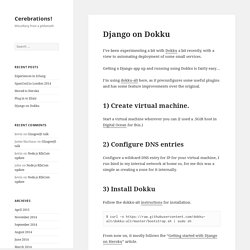
Getting a Django app up and running using Dokku is fairly easy… I’m using dokku-alt here, as it preconfigures some useful plugins and has some feature improvements over the original. 1) Create virtual machine. Start a virtual machine wherever you can (I used a .5GiB host in Digital Ocean for this.) 2) Configure DNS entries. Nbviewer.ipython.org/github/jseabold/538model/blob/master/silver_model.ipynb. Ferramentas para acelerar programas Python. Introducing Openshift : Heroku Replacement for Your Next Killer Python Web Application. Click here to register to Openshift and get your Free plan consisting of 3 applications, each having 1GB space quota If you already familiar enough with web application, I bet you know that finding a cheap (yes, cheap must come first) and reliable (then come reliability) hosting service for your PHP application is very easy.
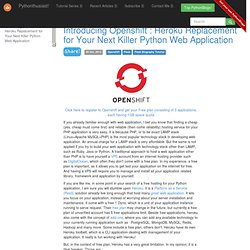
It is because PHP, or to be exact LAMP stack (Linux+Apache MySQL+PHP) is the most popular technology stack in developing web application. Gist/wrobstory/1eb8cb704a52d18b9ee8/Up and Down PyData 2014. Python and Flask Are Ridiculously Powerful. As a developer, I sometimes forget the power I wield.

It's easy to forget that, when something doesn't work the way I'd like, I have the power to change it. Yesterday, I was reminded of this fact as I finally got fed up with the way payments are processed for my book. After being unhappy with the three different digital-goods payment processors I've used since the book came out, I took two hours and wrote my own solution using Python and Flask. That's right. Two hours. Combining Tornado, MongoDB, and AngularJS to Build an App. Today for my 30 day challenge, I decided to take a break from JavaScript and learn a web framework called Tornado.
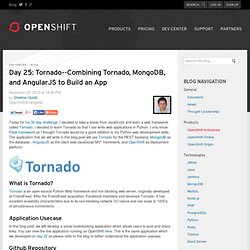
I decided to learn Tornado so that I can write web applications in Python. I only know Flask framework so I thought Tornado would be a good addition to my Python web development skills. The application that we will write in this blog post will use Tornado for the REST backend, MongoDB as the database , AngularJS as the client side JavaScript MV* framework, and OpenShift as deployment platform. An Article Extractor That Just Works. Today for my 30 day challenge, I decided to learn how to do article extraction using the Python programming language.
I have been interested in article extraction for a few month when I wanted to write a Prismatic clone. Prismatic creates a news feed based on user interest. Extracting article's main content, images, and other meta information is a very common requirement in most of the content discovery websites like Prismatic. In this blog post, we will learn how we can use a Python package called goose-extractor to accomplish this task. We will first cover some basics, and then we will develop a simple Flask application which will use the Goose Extractor API. Finding Sentiments in Text. Today for my 30 day challenge, I decided to take a break from JavaScript and learn about text processing using the Python programming language.
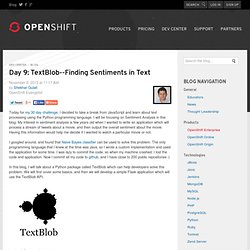
I will be focusing on Sentiment Analysis in this blog. My interest in sentiment analysis is few years old when I wanted to write an application which will process a stream of tweets about a movie, and then output the overall sentiment about the movie. Having this information would help me decide if I wanted to watch a particular movie or not. I googled around, and found that Naive Bayes classifier can be used to solve this problem. Home — Pygame Subset for Android. Python coming to the enterprise, like it or not. Java and .Net may be the staples of enterprise application development, but there's no doubt that the use of dynamic languages such as Python and PHP in the enterprise is exploding, albeit from a low base.

There's a strong body of anecdotal evidence to back up this assertion, and job posting rates for these languages monitored by Indeed show that, while Java and .Net job vacancies have been largely static, Python and PHP job posting numbers are going through the roof. What's driving enterprises to increasingly code in dynamic languages, and is it something you should be encouraging? Let's look at several key aspects of programming languages -- scalability, performance, developer productivity and security -- to see how Python stacks up to Java and .Net.
Productivity: Python code is cleaner, but does that matter? One argument is that dynamic languages let your developers be more productive, since they can get the same coding tasks done more quickly. Why Netflix is embracing Python over Java. Netflix is increasingly turning to Python over Java to power certain aspects of its video-streaming service, such as generating and processing alerts, boosting resilience, securing transactions, producing deployable AMIs (Amazon Machine Images), and for managing and automatic Cassandra clusters.
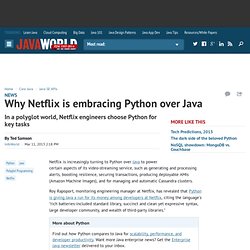
Roy Rapoport, monitoring engineering manager at Netflix, has revealed that Python is giving Java a run for its money among developers at Netflix, citing the language's "rich batteries-included standard library, succinct and clean yet expressive syntax, large developer community, and wealth of third-party libraries. " Python Scripts as a Replacement for Bash Utility Scripts. For Linux users, the command line is a celebrated part of our entire experience.

Unlike other popular operating systems, where the command line is a scary proposition for all but the most experienced veterans, in the Linux community, command-line use is encouraged. Often the command line can provide a more elegant and efficient solution when compared to doing a similar task with a graphical user interface. As the Linux community has grown up with a dependence on the command line, UNIX shells, such as bash and zsh, have grown into extremely formidable tools that complement the UNIX shell experience.
With bash and other similar shells, a number of powerful features are available, such as piping, filename wild-carding and the ability to read commands from a file called a script. Let's look at a real-world example to demonstrate the power of the command line. The series of commands in the following example show the power of more complex utilities by chaining together smaller building blocks: Python for Bash scripters: A well-kept secret. Python tutorial. Defining Python Source Code Encodings.
PEP Index> PEP 0263 -- Defining Python Source Code Encodings Abstract This PEP proposes to introduce a syntax to declare the encoding of a Python source file. The encoding information is then used by the Python parser to interpret the file using the given encoding. Most notably this enhances the interpretation of Unicode literals in the source code and makes it possible to write Unicode literals using e.g. UTF-8 directly in an Unicode aware editor. Problem In Python 2.1, Unicode literals can only be written using the Latin-1 based encoding "unicode-escape". Proposed Solution I propose to make the Python source code encoding both visible and changeable on a per-source file basis by using a special comment at the top of the file to declare the encoding.
Defining the Encoding Python will default to ASCII as standard encoding if no other encoding hints are given. Examples. Pre-processing text: R/tm vs. python/NLTK. Let’s say that you want to take a set of documents and apply a computational linguistic technique. If your method is based on the bag-of-words model, you probably need to pre-process these documents first by segmenting, tokenizing, stripping, stopwording, and stemming each one (phew, that’s a lot of -ing’s). In the past, I’ve relied on NLTK to perform these tasks. Python-recsys: A Python Library for building recommender systems.
Calling Python from R with rPython - ProgrammingR. Python has generated a good bit of buzz over the past year as an alternative to R. Personal biases aside, an expert makes the best use of the available tools, and sometimes Python is better suited to a task.